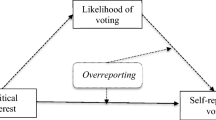Summary and conclusions
The marginal abstention hypothesis is that once at the polls, individuals are more likely to vote in the closer races on the ballot and to abstain from voting in the safer races. This hypothesis is a straightforward extension of the rational voting model. In previous empirical applications of the rational voter theory, voter turnout and voting in a given election are treated as one in the same. These studies have produced mixed results. When applied to the problem of explaining marginal voting behavior, the theory works well.
Data on a recent sample of U.S. House and Senate elections is used to test the marginal abstention hypothesis. In the average Congressional District, about three percent more people vote in the Senate race than in the House race. This difference varies in a fashion predictable by the theory.
Similar content being viewed by others
References
Barzel, Y., and Silberberg, E. (1973). Is the act of voting rational? Public Choice 16:51–58.
Buchanan, J.M., and Brennan, G. (1984). Voter choice: Evaluating political alternatives. American Behavioral Scientist 29(November/December):185–201.
Cebula, R.J., and Murphy, D.R. (1980). The Electoral College and voter participation rates: An exploration note. Public Choice 35:185–190.
Congressional Quarterly. (1983). Congressional districts in the 1980s. Washington, DC.
Crain, W.M. (1977). An empirical estimate of the income elasticity of political participation. Kyklos 30(Fasc. 1).
Crain, W.M., and Deaton, T.H. (1977). A note on political participation as consumption behavior. Public Choice 32:131–135.
Crain, W.M., Tollison, R.D., and Paulter, P. (1975). Information and voting: An empirical note. Public Choice (Winter).
Downs, A. (1957). An economic theory of democracy. New York: Harper and Row.
Foster, C.B. (1984). The performance of rational voter models in recent presidential elections. American Political Science Review 78(3):678–690.
Frey, B.S. (1971). Why do high income people participate more in politics? Public Choice 11:101–105.
Frey, B.A., Russell, K.D., and Fraser, J. (1971). Political participation and income level: An exchange. Public Choice 13:113–122.
Hinich, M.J. (1981). Voting as an act of contribution. Public Choice 36:135–140.
Kmenta, J. (1971). Elements of econometrics, page 370. New York: Macmillan.
Silberman, J., and Durden, G. The rational behavior theory of voter participation: The evidence from Congressional elections. Public Choice 23:101–108.
Tollison, R.D., and Willett, T.D. (1973). Some simple economics of voting and not voting. Public Choice 16:59–71.
Tullock, G. (1967). Toward a mathematics of politics. Ann Arbor: University of Michigan Press.
Tullock, G. (1976). The vote motive. London: Institute for Economic Affairs.
Author information
Authors and Affiliations
Additional information
We are grateful to Aslam Hameed for statistical assistance, and to Henry Butler, Martin Sabo, Bill Shughart, Robert Tollison, Gordon Tullock, and Asghar Zardkoohi for suggestions. We are responsible for any errors. The Center for Study of Public Choice and the Graduate School, GMU, provided financial support for the research.
Rights and permissions
About this article
Cite this article
Crain, W.M., Leavens, D.R. & Abbot, L. Voting and not voting at the same time. Public Choice 53, 221–229 (1987). https://doi.org/10.1007/BF00127347
Issue Date:
DOI: https://doi.org/10.1007/BF00127347




